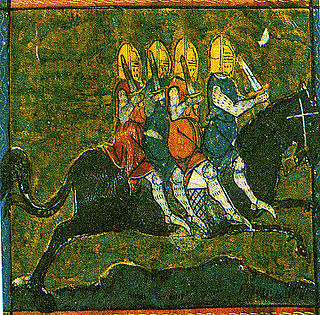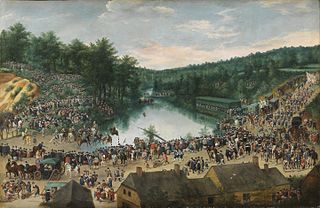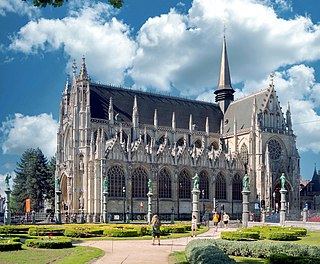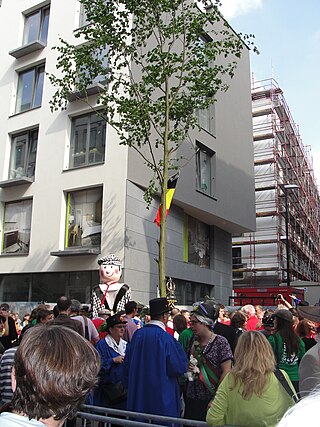
Manneken Pis is a landmark 55.5 cm (21.9 in) bronze fountain sculpture in central Brussels, Belgium, depicting a puer mingens; a naked little boy urinating into the fountain's basin. Though its existence is attested as early as the mid-15th century, Manneken Pis was redesigned by the Brabantine sculptor Jérôme Duquesnoy the Elder and put in place in 1619. Its stone niche in rocaille style dates from 1770. The statue has been repeatedly stolen or damaged throughout its history. Since 1965, a replica has been displayed, with the original stored in the Brussels City Museum.

The Grand-Place or Grote Markt is the central square of Brussels, Belgium. It is surrounded by opulent Baroque guildhalls of the former Guilds of Brussels and two larger edifices; the city's Flamboyant Town Hall, and the neo-Gothic King's House or Bread House building, containing the Brussels City Museum. The square measures 68 by 110 metres and is entirely paved.

Bayard is a magical bay horse in the legends derived from the medieval chansons de geste. These texts, especially that of The Four Sons of Aymon, attribute to him magical qualities and a supernatural origin. He is known for his strength and intelligence, and possesses the supernatural ability to adjust his size to his riders.

Processional giants are costumed figures in European folklore, particularly present in Belgian, French, Portuguese, Spanish, and English folkloric processions. The main feature of these figures is typically their wooden, papier maché or -more recently- synthetic resin head, whilst bodies are covered in clothing matching the costume's theme.

The City of Brussels is the largest municipality and historical centre of the Brussels-Capital Region, as well as the capital of the Flemish Region and Belgium. The City of Brussels is also the administrative centre of the European Union, as it hosts a number of principal EU institutions in its European Quarter.

Brussels Park is the largest urban public park in central Brussels, Belgium. Formerly known and still sometimes colloquially referred to as the Royal Park, it was the city's first public park, being originally laid out between 1776 and 1783 in a neoclassical style by the French architect Gilles-Barnabé Guimard and the Austrian landscape architect Joachim Zinner, as part of an urban project including the Place Royale/Koningsplein. The area of the rectangular park is 13.1 ha.

Ommegang or Ommeganck is the generic name for various medieval pageants celebrated in the Low Countries.

Denis van Alsloot or Denijs van Alsloot was a Flemish landscape and genre painter, draughtsman, and tapestry designer. He was employed as a court painter and worked for the local elite in Brussels. He is considered to be a member of the Sonian Forest school of landscape painters, which included landscape painters such as Jacques d'Arthois and Cornelis Huysmans. These painters working in Brussels had a preference for depicting scenes from the Sonian Forest near Brussels. Van Alsloot was also a specialist in depicting civil processions, local festivals and ceremonies.

Saint V (French), Sint V (Dutch) or St V are the commonly used names for a holiday for freethinking university students in Brussels, Belgium. It takes place annually on 20 November and commemorates the founding of the Free University of Brussels on 20 November 1834. The day's long forms differ in the two official languages, but both are a reference to Pierre-Théodore Verhaegen, the university's founder, who notably is not a saint and was never canonized; the name was chosen instead to mock the Saint-Nicolas festivities of the rival Catholic University.

The Seven Noble Houses of Brussels were the seven families or clans whose descendants formed the patrician class and urban aristocracy of Brussels, Belgium.

Sculpture in Brussels is sculpture that has been created in Brussels, Belgium, since the Middle Ages to the present day. It began to shine in the second half of the 14th century with Claus Sluter's arrival in Brussels and the construction of Brussels' Town Hall. It continued without interruption and reached its momentum during 15th and 16th centuries. Until the end of the Ancien Régime, sculptors in Brussels were members of the Quatre Couronnés Guild of the Nation of St Nicholas and then the Royal Academy of Fine Arts.

The following is a timeline of the history of Brussels, Belgium.
The Folklore of Belgium is extremely diverse and reflects the rich legacy of cultural and religious influences which have acted on the region throughout its history, even before the establishment of the nation of Belgium in 1830. Much of Belgian folklore is unique to the region in which it is commemorated. Many aspects of folklore are manifested in public processions and parades in Belgian cities; traditions which are kept alive for the amusement of locals and tourists alike.

The Church of Our Lady of Victories at the Sablon, or the Church of Our Lady of the Sablon, is a Roman Catholic church located in the Sablon/Zavel district, in the historic centre of Brussels, Belgium. It is dedicated to Our Lady of the Sablon.

The Sablon or Zavel is a neighbourhood and hill in the historic upper town of Brussels, Belgium. At its heart are twin squares: the larger Grand Sablon or Grote Zavel square in the north-west and the smaller Petit Sablon or Kleine Zavel square and garden in the south-east, divided by the Church of Our Blessed Lady of the Sablon. This area is served by Brussels-Chapel railway station and Brussels-Central railway station, as well as the tram stop Petit Sablon/Kleine Zavel.

The processional giants and dragons of Belgium and France are a set of folkloric manifestations involving processional giants, which have been inscribed by UNESCO on the lists of Intangible Cultural Heritage in 2008, originally proclaimed in November 2005.
Events in the year 2017 in Belgium.

The Ducasse d'Ath is a traditional parade held to mark the victory of David over Goliath that takes place in the town of Ath in Belgium.

The Meyboom plantation is the oldest tradition in Brussels, Belgium, attested since 1308. It is held every year on 9 August, the eve of St Lawrence's Day, and consists mainly in planting a beech at the intersection of the Rue des Sables/Zandstraat and the Rue du Marais/Broekstraat in the City of Brussels' Marais–Jacqmain District. It is accompanied by processions and various folk activities during the day.
The Association Royale des Descendants des Lignages de Bruxelles (French) is a hereditary organization of individuals who have documented their descent from at least one member of the Seven Noble Houses of Brussels.





















